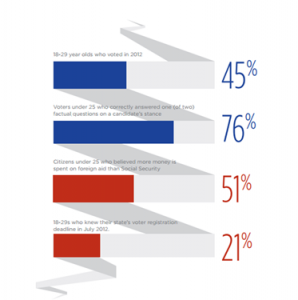A recent study reported that the percentage of youth who vote is still significantly lower than the national average for all ages and blamed both demographic and political factors.
The Center for Information and Research on Civic Learning & Engagement, or CIRCLE, released a study by commissioners stating that the youth voting turnout has stayed relatively the same since 1970. The 50 percent mark has not been breached in 42 years.

The amount of college and post college education seems to be directly proportional to the likelihood of someone voting, according to the study. But there is a large gap of voters, ages 18–25, who are still not voting.
CIRCLE attributes low percentage of voters to the stronger polarization of political parties. When the Republicans and Democrats battle, as recently evidenced with the government shutdown, it leads to an aversion to involvement.
“Polarization contributes to failures of governance, such as repeated fiscal crises in Washington, D.C.,” CIRCLE said. “The constant controversy and struggle for advantage also lead many Americans to disdain politics, to mistrust their fellow citizens, and sometimes to view other Americans’ political participation with hostility.”
In the last presidential election, President Obama was able to tap into the youth vote by working with youth voters’ energy in the polarization. The youth vote has largely been ignored up till now, but using social media to play upon the “hype” proved beneficial in securing more youth votes.
Ben Layton, who is currently studying political science and economics, says he thinks “the trend is on the rise.”
“I think college-age students tend to be more liberal as a response to the strongly conservative Republican party,” Layton said. “The polarization gives hype that the students buy into. So when reached out to, they respond. But the youth vote has been largely ignored.”
Richard Davis, a political science professor, agreed, saying the larger youth vote for Obama was unusual.
“Elected officials typically don’t appeal to young people,” Davis said. “The vote just hasn’t been important enough.”
The CIRCLE report elaborated on the point.
“Young people are special targets of suspicion,” the CIRCLE report said. “Commissioners are struck by the controversy about whether youth voting is desirable and whether promoting it can be a nonpartisan goal.”
Being ignored by those campaigning may be a large factor in the low percentage of youth voters, but there are many other reasons to consider.
“One reason is the transient nature of many young people,” Davis said. “Where they are going to college is not where they expect to live permanently or where they are from.”
Many youth voters know their residence is only temporary and do not have a sense of responsibility to participate in local politics. Davis says they haven’t developed a sense of “stake.”
“They tend not to pay much in income taxes,” Davis said. “They don’t pay property taxes. They rarely have children in school. They don’t belong to a residential neighborhood where there is that sense of stake. Plus they are not surrounded by others who vote, which means there is little social incentive.”
Students tend to be busy with the college lifestyle and don’t believe they have the time to vote, or don’t know where to start. There is also a lack of civic knowledge available through the public school system. The requirements in the classrooms do not always adequately equip young people with the tools to be civilly involved.
“Young people do not automatically acquire the skills, knowledge, motivations and values necessary to contribute to the republic; they must be educated and encouraged,” CIRCLE said. “Certainly, the current policies in states and major school districts do not come close to achieving the goals of civic education, which are to provide all young people with the knowledge, skills and dispositions they need to be active and responsible citizens.”
The CIRCLE commissioners hope to raise awareness of the lack of voters and to encourage dialogue on how to solve the issue. They list several ideas to begin with, which include lowering the voting age to 17, raising state standards on civic courses, and making voting more accessible through same-day and auto registration.




